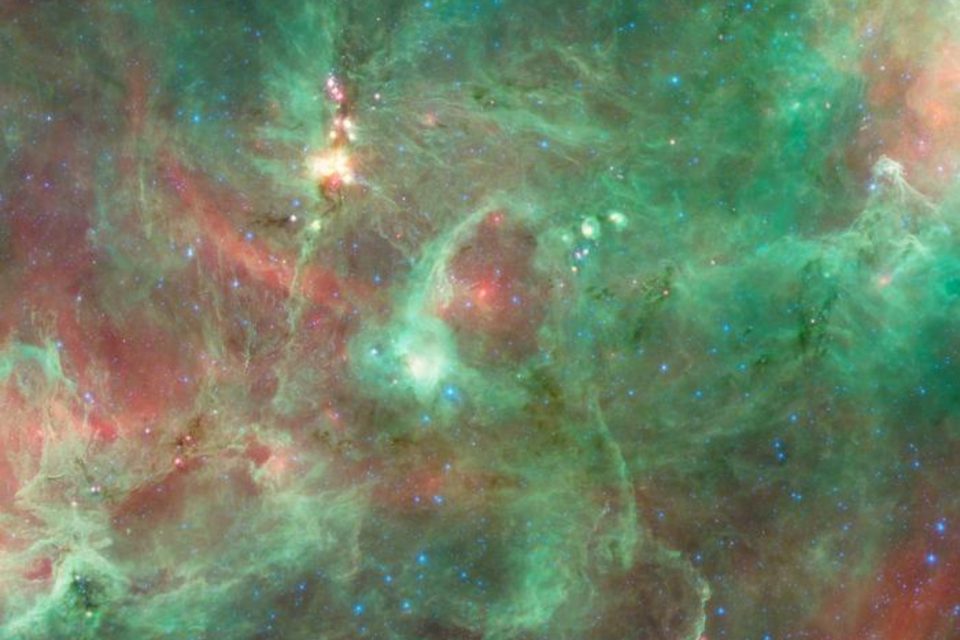Mysterious ‘Diamond Ring’ in space isn’t what it seems
Today’s Image of the Day from NASA’s Jet Propulsion Laboratory shows a striking feature in the star-forming region Cygnus X that astronomers call the “Diamond Ring.”
At first glance, it looks like a shimmering loop of light set against a busy background of stars.
The Diamond Ring has been a familiar sight to infrared telescopes for years, but its unusual shape has puzzled researchers for just as long.
How the Diamond Ring is different
Many rings in space form as perfect spheres, yet this one is noticeably flat. That odd detail raised all kinds of questions about what happened here and what forces shaped it.
In the vast sweep of our galaxy, stars regularly reshape their surroundings as they form, grow, and finally burn out.
They blow bubbles in the gas and dust around them, clearing out pockets and stirring up new regions where fresh stars can take shape. These bubbles usually expand in all directions, forming large, round shells as they push outward.
The “Diamond Ring,” however, does not follow that script. It stretches across about 20 light years and gives off a bright infrared glow, but it doesn’t curve into a complete shell. It appears as a flattened ring instead of a sphere.
Why the bubble burst
An international team of researchers studied this strange formation in detail and found that it is the final stage of a cosmic bubble that behaved very differently from others like it.
Their work shows how the bubble formed, why it looks this way today, and what it can teach us about the life cycles of stars.
According to the study, the structure seen now is the leftover of a bubble made of ionized carbon. It was once inflated by a massive star whose radiation and winds pushed into the cloud around it.
This star had a mass roughly 16 times that of the Sun and was energetic enough to heat the surrounding gas and dust until it glowed.
“For the first time, we observed the final stage of such a gas bubble in a distinctly flat cloud structure,” explained Simon Dannhauer, who led the study.
“The bubble has ‘burst’ because gases were able to escape into the thinner areas around it. All that remained was the particular flat shape.”
How the bubble formed
Computer simulations show the bubble first expanded evenly in all directions. As it grew, it eventually reached weaker, less dense parts of the cloud.
At that point, the hot gas inside the bubble leaked out. This release caused the bubble to lose its symmetrical shape and collapse into the flattened ring seen today.
The entire structure is thought to be about 400,000 years old. That might sound ancient, but it is considered very young when compared to the typical lifespan of massive stars.
Sebastian Vider carried out the simulations using the RAMSES supercomputer. These models helped scientists test how the bubble behaved over time and confirm that its escape route through the cloud explains its current shape.
Without that thinning in the surrounding material, the bubble would likely have kept its spherical form.
A slow-moving ring
The team measured the motion of the ring with data from the flying observatory SOFIA, the Stratospheric Observatory for Infrared Astronomy.
SOFIA was a modified Boeing aircraft equipped with an infrared telescope that flew more than 8 miles above Earth.
That altitude opened up a slice of the infrared spectrum that ground-based observatories cannot see. These observations made it possible to track how the gas in the ring is moving.
The ring expands at around 1.3 kilometers per second – this corresponds to around 4,700 km/h and is actually quite slow compared to similar bubbles. That slow pace fits with its advanced evolutionary stage.
The bubble has shed much of its original pressure, and what remains is drifting outward without the strong push that once drove it.
Why it matters for star formation
The research highlights how young, energetic stars can reshape their surroundings. Even a single massive star can sweep aside large portions of a cloud and set the stage for new stars to emerge somewhere else.
Dr Nicola Schneider noted that the Diamond Ring shows how enormous the influence of individual stars can be on entire cloud complexes.
Dr Robert Simon added that such processes are crucial for understanding the formation of stars in our Milky Way.
The findings give astronomers a clearer sense of how bubbles evolve and why no two regions look exactly the same.
Each bubble records a chapter in the history of the cloud that hosts it, shaped by both the star at its center and the uneven landscape of gas and dust around it.
Over time, these interactions help determine where clusters form, how they spread out, and what kinds of stars they produce.
A final twist in the story
There is one more surprise tied to the “Diamond Ring.” The bright clump known as the “diamond” isn’t actually part of the ring at all. It only looks connected from Earth because the two objects align so neatly in the sky.
In reality, the cluster of young stars sits a few hundred light years closer to us. It just happens to fall in the same line of sight, creating the illusion of a gemstone set into a cosmic band.
The new study clears up the mystery behind the ring’s appearance and shows how a bubble’s life can end in a way few astronomers expected.
The research reveals a chapter in the story of star-forming regions that had been missing, offering a closer look at how these clouds breathe, collapse, and change as young stars come and go.
Image Credit: NASA/JPL-Caltech/Harvard-Smithsonian CfA
—–
Like what you read? Subscribe to our newsletter for engaging articles, exclusive content, and the latest updates.
Check us out on EarthSnap, a free app brought to you by Eric Ralls and Earth.com.
—–




















